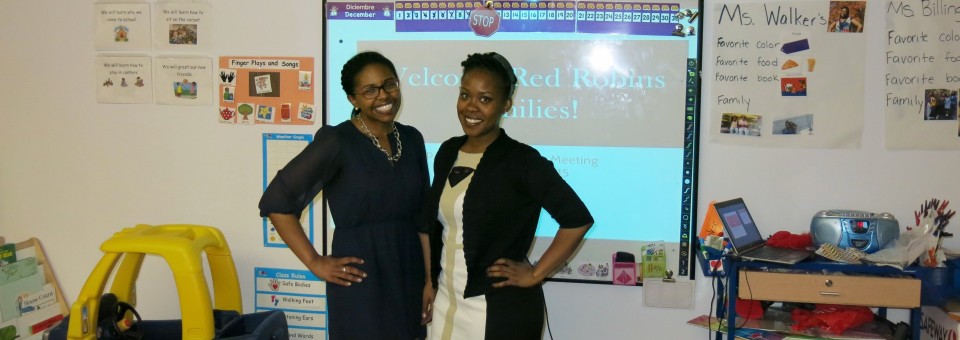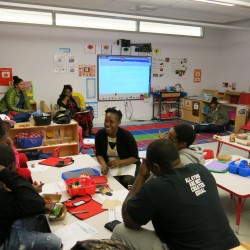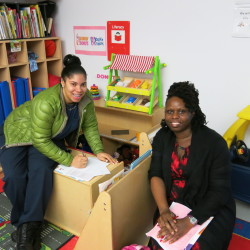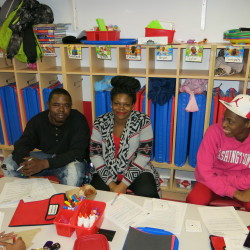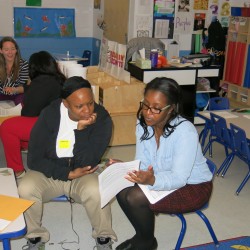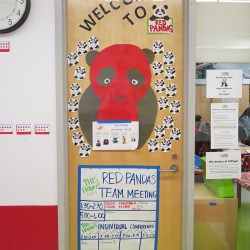Parent Teacher Conferences (PTCs) are an education staple. They happen three times a year in most D.C. public schools and are as commonplace to a school environment as sending out progress reports to parents or having teacher planning days. Still, the purpose behind these meetings is truly commendable: to give parents a dedicated space to communicate with teachers about their children’s academic progress and goals.
So how do we frame PTCs in a way that reinvigorates them, gets teachers excited to implement them, parents excited to attend, and allows students to reap the benefits of a fruitful interaction between their teachers and parents? A group of preschool teachers in Flamboyan’s Charter Teacher Family Engagement Professional Learning Community (PLC) from KIPP DC: Grow Academy worked together to come up with a truly innovative solution.
Having just finished a cycle of PTCs at their school, the KIPP team wanted to interact with parents in a different, more targeted way than standard PTCs had achieved. As preschool teachers, the team identified a couple of specific problems during parent interviews: a lack of time during PTC days to effectively communicate each student’s data to his/her families, and a lack of time for students’ families to network and get to know one another.
Teachers LaTia Walker and Sherie Billingslea decided to focus their PTC on sharing students’ social-emotional data with families. KIPP DC schools have standards-based assessments used to determine preschoolers’ social-emotional growth, and the KIPP teachers wanted to make sure parents understood what this growth looks like. As Ms. Walker explained, “We wanted to break it down to parents…what [social-emotional learning] looks like at home and at school, so that we could all have fluid expectations.” She added, “We wanted to put tools in parents’ hands for them to be able to help their children develop their social-emotional learning at home.”
One of the tools teachers developed for the PTC was a handout created using resources from the Devreux Early Childhood Assessment (DECA) Preschool Program, which included a list of self-regulation strategies for parents to try at home and examples of what self-regulation looks like.

Printed meeting materials for parents, including: the meeting PowerPoint, a self-regulation goals sheet, and a self-regulation tip sheet.
Optimistic that their choice to share data on social emotional growth, Ms. Walker and Ms. Billingslea went a step further and scheduled an additional PTC with a goal of 50 percent attendance. Their classroom surpassed the goal.
How did they get so many parents to attend an additional and voluntary PTC? Ms. Walker stressed the importance of already having established strong relationships with the families through home visits, ongoing communication, and through the previous PTC.
They used these interactions to set a high expectation for parent participation. In fact, during the first round of PTCs, teachers informed parents that they would connect with them to conduct interviews and get their input on things they would like to see in this PTC, as well as to gauge the best dates and time to maximize attendance. Finally, they sent home sign-up sheets with students’ folders and offered parents two times to attend — once in the morning and another in the afternoon.
In the end, the teachers’ efforts paid off. They were delighted with the high parent participation and noticed parents engaging with the handouts, asking thoughtful questions about social-emotional learning, and analyzing their children’s data. Although it is difficult to determine the exact effects of this PTC on student achievement, the KIPP team is confident parents left with a greater understanding of social-emotional development.
In terms of lessons learned, Ms. Walker added that to improve upon this tactic in future meetings, she would plan individualized handouts for parents with more academic information, including strategies targeted to individual students’ needs. She also said she would follow up with a survey to get feedback and input from parents on their perceptions of the PTC.
Putting a different spin on PTCs was a great success for the KIPP preschool teachers. They were able to engage parents in meaningful conversations about their children and equip them with tools to support their children’s development. They were also able to share their projects and the lessons learned to their colleagues at the next PLC meeting. Notably, exit slips from the meeting revealed that KIPPs presentation not only impressed participants, but also gave them a new sense of excitement to carry out their own innovation projects.
The innovative PTCs at KIPP DC: Grow Academy show that educators with the belief in the powerful effects of family engagement, the will to find innovative ways to build and strengthen relationships with students’ families, the space to exchange ideas and feedback with like-minded colleagues, and the support to carry out these projects effectively, all create a strong recipe for piloting new ways engage families in order to improve student outcomes.
About the PLC
The PLC gives participants the opportunity to plan and implement an innovative family engagement initiative at their school and present their initiative to their community of peers. To do so, teachers are asked to analyze student data, reflect on their patterns of interactions with students’ families, and conduct parent interviews to identify a challenge they wish to tackle. Flamboyan’s role is facilitator, making its staff available during the process to give teachers feedback on their ideas and planning, to provide resources and support to carry out their projects, and to bring PLC participants together so that they can receive peer feedback throughout the process. There are 62 teachers participating in the PLC.
A Closer Look at the Meetings
- Ms. Bilingslea interacts with a group of parents during the PTC.
- Two parents engage in conversations about the content and materials received during the meeting.
- Families engage with the meeting materials and with each other during the PTC.
- In another innovative PTC, preschool teacher Ms. Lewis looks at a student’s data with her mother.
- Ms. Morman creates an inviting atmosphere at her PTC with lively door decorations.

